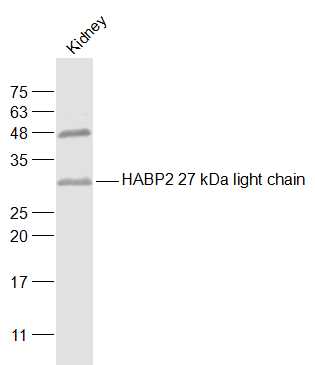HABP2 27 kDa light chain Rabbit pAb
HABP2 27 kDa light chain Rabbit pAb
- 产品详情
- 实验流程
- 背景知识
Application
| WB |
|---|---|
| Primary Accession | Q14520 |
| Reactivity | Mouse |
| Predicted | Human, Rat, Horse, Rabbit |
| Host | Rabbit |
| Clonality | Polyclonal |
| Calculated MW | 62672 Da |
| Physical State | Liquid |
| Immunogen | KLH conjugated synthetic peptide derived from human Hyaluronan-binding protein 2 27 kDa light chain |
| Epitope Specificity | 271-370/560 |
| Isotype | IgG |
| Purity | affinity purified by Protein A |
| Buffer | 0.01M TBS (pH7.4) with 1% BSA, 0.02% Proclin300 and 50% Glycerol. |
| SUBCELLULAR LOCATION | Secreted. Secreted as an inactive single-chain precursor and is then activated to a heterodimeric form. |
| SIMILARITY | Belongs to the peptidase S1 family. Contains 3 EGF-like domains. Contains 1 kringle domain. Contains 1 peptidase S1 domain. |
| SUBUNIT | Heterodimer; disulfide-linked. Heterodimer of a 50 kDa heavy and a 27 kDa light chain linked by a disulfide bond. |
| Post-translational modifications | Proteolytic cleavage at Gly-23 or Met-27 can give rise to the 50 kDa heavy chain and cleavage at Arg-313 or Lys-319 can give rise to the 27 kDa light chain. The heavy chain can undergo further proteolytic cleavage at Lys-169 or Arg-170 to give rise to 2 inactive 26 kDa fragments and the light chain can undergo further proteolytic cleavage at Arg-480 to give rise to inactive 17 kDa and 8 kDa fragments. |
| Important Note | This product as supplied is intended for research use only, not for use in human, therapeutic or diagnostic applications. |
| Background Descriptions | The protein encoded by this gene is an extracellular serine protease that binds hyaluronic acid and is involved in cell adhesion. The encoded protein is synthesized as a single chain, but then undergoes an autoproteolytic event to form the functional heterodimer. Further autoproteolysis leads to smaller, inactive peptides. This protease is known to cleave urinary plasminogen activator, coagulation factor VII, and the alpha and beta chains of fibrinogen, but not prothrombin, plasminogen, or the gamma chain of fibrinogen. Two transcript variants encoding different isoforms have been found for this gene. [provided by RefSeq, Apr 2010] |
| Gene ID | 3026 |
|---|---|
| Other Names | Factor VII-activating protease, FSAP, 3.4.21.-, FVII activator, Hepatocyte growth factor activator-like protein, Hyaluronan-binding protein 2, Plasma hyaluronan-binding protein, PHBP, Plasma hyaluronan-binding serine protease, PHBSP, Factor VII-activating protease 50 kDa N-terminal heavy chain, Factor VII-activating protease 50 kDa N-terminal heavy chain alternate form, Factor VII-activating protease 27 kDa C-terminal light chain, Factor VII-activating protease 27 kDa C-terminal light chain alternate form, HABP2 {ECO:0000303|PubMed:26222560, ECO:0000312|HGNC:HGNC:4798} |
| Target/Specificity | Ubiquitously expressed. |
| Dilution | WB=1:500-2000 |
| Storage | Store at -20 °C for one year. Avoid repeated freeze/thaw cycles. When reconstituted in sterile pH 7.4 0.01M PBS or diluent of antibody the antibody is stable for at least two weeks at 2-4 °C. |
| Name | HABP2 {ECO:0000303|PubMed:26222560, ECO:0000312|HGNC:HGNC:4798} |
|---|---|
| Function | Cleaves the alpha-chain at multiple sites and the beta-chain between 'Lys-53' and 'Lys-54' but not the gamma-chain of fibrinogen and therefore does not initiate the formation of the fibrin clot and does not cause the fibrinolysis directly (PubMed:11217080). It does not cleave (activate) prothrombin and plasminogen but converts the inactive single chain urinary plasminogen activator (pro-urokinase) to the active two chain form (PubMed:10754382, PubMed:11217080). Activates coagulation factor VII (Probable). May function as a tumor suppressor negatively regulating cell proliferation and cell migration (PubMed:26222560). |
| Cellular Location | Secreted. Note=Secreted as an inactive single-chain precursor and is then activated to a heterodimeric form |
| Tissue Location | Ubiquitously expressed. |
For Research Use Only. Not For Use In Diagnostic Procedures.
Provided below are standard protocols that you may find useful for product applications.
BACKGROUND
The protein encoded by this gene is an extracellular serine protease that binds hyaluronic acid and is involved in cell adhesion. The encoded protein is synthesized as a single chain, but then undergoes an autoproteolytic event to form the functional heterodimer. Further autoproteolysis leads to smaller, inactive peptides. This protease is known to cleave urinary plasminogen activator, coagulation factor VII, and the alpha and beta chains of fibrinogen, but not prothrombin, plasminogen, or the gamma chain of fibrinogen. Two transcript variants encoding different isoforms have been found for this gene. [provided by RefSeq, Apr 2010]
终于等到您。ABCEPTA(百远生物)抗体产品。
点击下方“我要评价 ”按钮提交您的反馈信息,您的反馈和评价是我们最宝贵的财富之一,
我们将在1-3个工作日内处理您的反馈信息。
如有疑问,联系:0512-88856768 tech-china@abcepta.com.























 癌症的基本特征包括细胞增殖、血管生成、迁移、凋亡逃避机制和细胞永生等。找到癌症发生过程中这些通路的关键标记物和对应的抗体用于检测至关重要。
癌症的基本特征包括细胞增殖、血管生成、迁移、凋亡逃避机制和细胞永生等。找到癌症发生过程中这些通路的关键标记物和对应的抗体用于检测至关重要。 为您推荐一个泛素化位点预测神器——泛素化分析工具,可以为您的蛋白的泛素化位点作出预测和评分。
为您推荐一个泛素化位点预测神器——泛素化分析工具,可以为您的蛋白的泛素化位点作出预测和评分。 细胞自噬受体图形绘图工具为你的蛋白的细胞受体结合位点作出预测和评分,识别结合到自噬通路中的蛋白是非常重要的,便于让我们理解自噬在正常生理、病理过程中的作用,如发育、细胞分化、神经退化性疾病、压力条件下、感染和癌症。
细胞自噬受体图形绘图工具为你的蛋白的细胞受体结合位点作出预测和评分,识别结合到自噬通路中的蛋白是非常重要的,便于让我们理解自噬在正常生理、病理过程中的作用,如发育、细胞分化、神经退化性疾病、压力条件下、感染和癌症。






